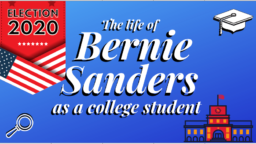College is meant to be a time of self-discovery and self-improvement. And like many students before and after him, presidential candidate Sen. Bernie Sanders (I-Vt.) used his college years to mold himself into the man he is today. It’s not a surprise that the bulk of Sanders’ time in school was not spent on the athletic field, fraternity row or even in the classroom, but instead on protesting injustices on campus and in the greater community.
It was 60 years ago when Sanders, 18 years old at the time, first enrolled at Brooklyn College, just over a mile north of the house he grew up in and equidistant to his alma mater James Madison High School.
Like most young adults, Sanders left high school full of unsettled ambition. At the time, his mother was also dealing with heart complications. Sanders’ decision to attend college near home, as many students did in the late 1950s, was influenced in part by his desire to stay close to his family.
By the end of his freshman year, however, life events had motivated Sanders to move on. In the fall of 1960, he transferred to the University of Chicago.
“My mom had died the previous year, and I felt it was time to leave the neighborhood and see what the rest of the world looked like,” Sanders told a crowd of new graduates and their families while speaking at Brooklyn College’s 2017 Commencement.
Although Sanders enrolled at UChicago as an English major, he quickly transitioned to political science after becoming involved with social activism on campus.
In the years leading up to Sanders’ arrival, UChicago had become known for having a politically progressive staff and student body.
“(UChicago) had a reputation of radicalism during the 1950s. During the Red Scare, a number of (UChicago) faculty members were accused of being communists,” Ray Gadke, a UChicago librarian, told the Chicago Tribune. “That was the generation before Bernie was here, but there was still that reputation of being a red school — a radical school — when he was here.”
In the classroom, Sanders was a mediocre student who generally found schoolwork boring and irrelevant, and learned “infinitely more on the streets and in the community,” the New Yorker reported.
Early on in his time at UChicago, Sanders became a student chairman of the Congress of Racial Equality (CORE)’s social action committee. Through the organization, he helped lead protests and sit-ins, including a famous two-week sit-in at the office of university President George Beadle over segregationist policies at university-owned apartments.
In the spring of 1961, a group of four students were looking to rent one of UChicago’s Hyde Park apartments. Because one of the students was black, however, they were being “turned down everywhere,” the university’s student-led newspaper Chicago Maroon reported.
In an effort to prove racial bias, the students were advised by one of their fathers to “test the university” by sending groups of white students and groups of black students separately to inquire about the apartments.
Months later, the student government and CORE carried out a total of six of these tests and found dicrimination against black students in each scenario. In one particular test, a black student asked the university for an apartment on a street with multiple vacancies that would cost $80-$90 a month, and the university responded there were none available for less than $125. Just after, the university rented an apartment on the same street to a white student for $75 a month, according to the Maroon.
When the student groups displayed their findings to President Beadle, he justified the housing discrimination, referencing the need for “stable integration.”
The next day, January 23, 1962, a crowd of more than 200 students picketed outside the president’s office. In front of this crowd, 21-year-old Sanders stood up and said: “We feel it is an intolerable situation when Negro and white students of the university cannot live together in university-owned apartments,” the Chicago Maroon reported.
Soon after, Sanders decided to take the fight against racial injustice to the streets. As the chairman of CORE, he led picketers at a Howard Johnson in Cicero, Illinois, to “keep the pressure on” the restaurant chain after 12 CORE activists were arrested for trying to eat at one of its segregated restaurants in North Carolina, according to Mother Jones.
And in 1963, Sanders was arrested and fined $25 for protesting segregation at Chicago public schools. He was speaking out against the use of “Willis Wagons,” named sarcastically after Chicago public school Superintendent Benjamin Willis who was reportedly hated by the black community. The Willis Wagons, which were essentially modular trailers, were being used as overflow classrooms in crowded, predominantly black public schools. At the same time, the white schools in the district were reported to have excess room to take in more students but refused to do so.
Although he gained valuable experience and clearly found his political calling while fighting injustice on UChicago’s campus and in its surrounding community, Sanders’ grades fell as a result. Just after the Howard Johnson protest, a university dean asked him to take time off from school, and he had to leave his leadership position at CORE, according to Mother Jones.
Nonetheless, Sanders would go on to graduate from UChicago in 1964 with a bachelor’s degree in political science.
After multiple political defeats running for governor of Vermont and for a U.S. senator position, Sanders would finally be elected to office in 1981 as the mayor of Burlington, Vermont. This sparked the beginning to what has become a long, successful career in politics. Sanders went on to hold a seat representing Vermont in the U.S. House of Representatives from 1991 to 2007, and then proceeded to join the U.S. Senate.
Now, as a candidate for president, Sanders still holds onto many of the same political ideas and beliefs he had on UChicago’s campus in the early 1960s. To this day, he remains the passionate student protester he once was.



